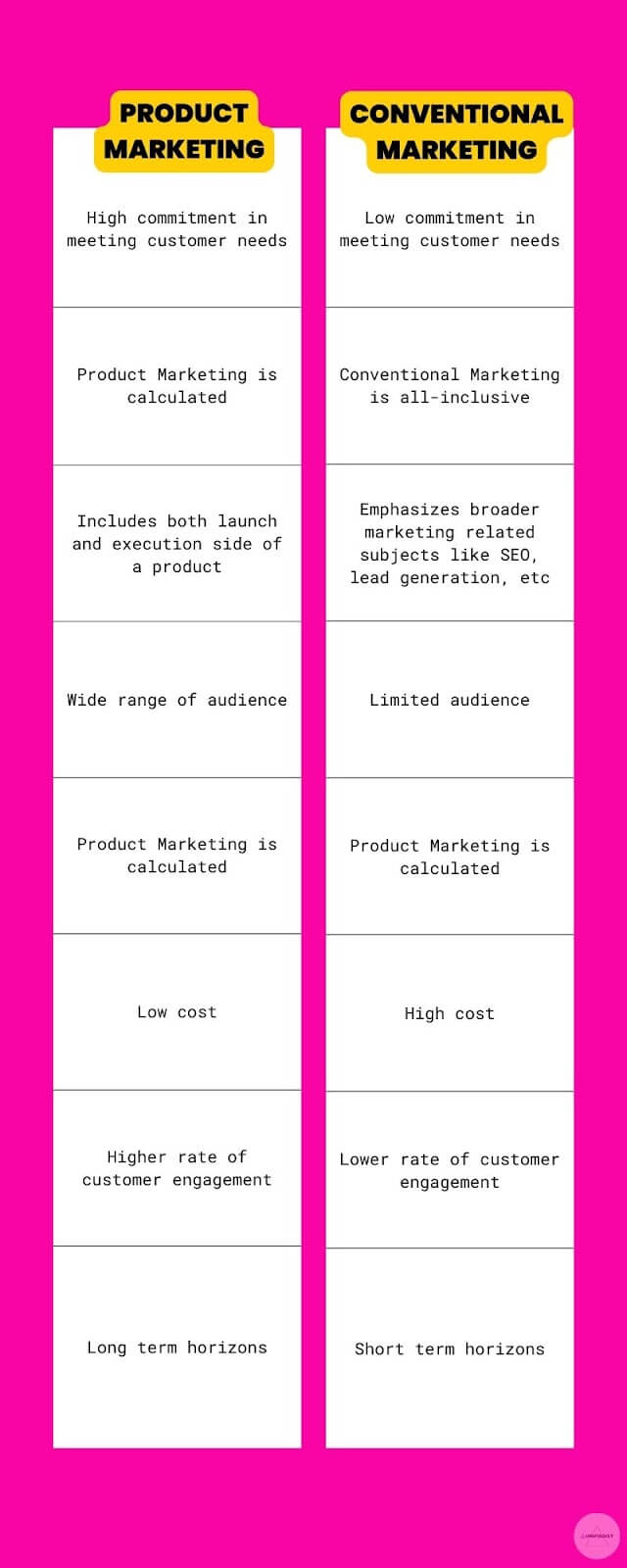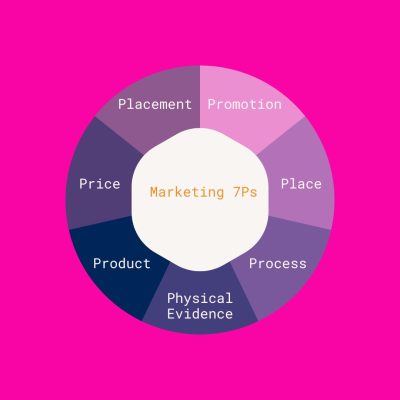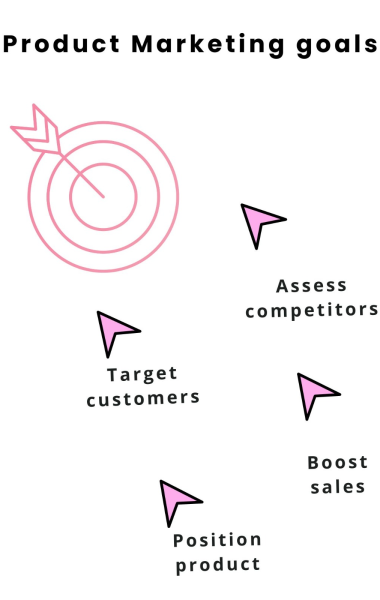8 Must-Try Online Product Marketing Strategies
Share
Even though product marketing is a crucial division in most businesses, only some accurate definitions state that product marketing lies at the nexus of product, marketing, and sales is one of the reasons why a clear definition of it is difficult to find.
Simply put, product marketing bridges the gap between product management and marketing. Even if your business only sells a single or a small number of goods, a good product marketing plan is still important.
So what exactly is product marketing? In this comprehensive guide, we will answer what product marketing is, how a product can be successfully marketed & what makes effective product marketing strategies.
So, Let’s dive in.
What you will find in this article:
1. Product Marketing vs. Conventional Marketing
2. Understanding Product marketing goals
3. 8 game-changing product marketing strategies
Product Marketing vs. Conventional Marketing
Your product marketing strategy guides introducing, marketing, and selling your new product. In addition, you can use it to find out who your biggest fans are and how to contact them.
But what is it anyway?
Understanding Product Marketing
The process of bringing a product to the market, publicising it, and persuading consumers to buy it is known as product marketing. To increase sales & demand for the product, product marketing includes identifying the target market and using strategic positioning and messaging.
Your product marketing strategies should consider the entire product life cycle, from conception to expansion. It needs feedback from product managers, marketing managers, marketers, and sales teams for its creation and implementation. Finally, it needs to be built on reliable consumer information.
But what stands out about product marketing? What distinguishes it from conventional marketing? Let’s explore the differences.
Product Marketing vs. Conventional Marketing – where does it differ?

While conventional marketing is all-inclusive, product marketing is calculated. A part of conventional advertising is regarded to be product marketing. Product marketing is one of the most crucial facets of a company’s marketing efforts, as you can see from the seven P’s of marketing.
Product marketing is developing a product’s positioning and messaging to appeal to a target audience after thoroughly figuring out that audience. The work of a product marketer sits at the core of a company’s marketing, sales, and product teams because it includes both the launch and execution side of a product and the product’s marketing strategy.

Conventional marketing emphasises broader marketing-related subjects like lead generation, SEO, and anything that has to do with attracting and converting new leads and customers. It’s about promoting the business and overall image, including the products offered for sale. These marketers ensure the company’s content has a unified, on-brand theme.
Let’s explore product marketing goals to gain a better understanding of them.
Understanding Product marketing goals
Product marketing is centred on driving interest in and adoption of a product among existing customers. It focuses on consumers’ actions to buy your product, allowing product marketers to create campaigns to aid in this effort.
Typically, product promotion is carried out with the following goals in mind:
Understanding audience: When you use online product marketing strategies, your target market will be able to recognize the benefits of owning that particular product. You can perform customer research by knowing how many customers favour your product.
Targeting buyers: You can figure out the kind of buyer persona to target in the future by knowing your customers and their needs. When you innovate your product to meet the requirements of your target market better, knowing their precise needs can be valuable.
Learning about competitors: You can evaluate your approach and outcomes concerning your competition when you advertise your products. Here, you can ask yourself: What aspects and advantages of their goods stand out in the market? What concepts haven’t they looked into? What distinguishes their offering from mine?
This research can benefit you as you create your product marketing strategy.

Ensuring collaboration among teams: Making your product offering abundantly obvious to consumers and employees suits both parties. Your company’s teams can more effectively convey the goal of the product and better understand it as a whole.
Positioning product: You want your product, brand image, and tone to be constant in product marketing and to evoke the right emotions in your target market. However, when you brainstorm your product positioning, there are some things to think about are:
1.Is this offering appropriate for the market of today?
2. What distinguishes these products from those of our rivals?
3. Can we further set this product apart from those of our rivals?
4. Are there any previously sold goods that we wouldn’t promote or market?
Why not, then?
It is key to assuring the product’s viability on the market. Over time, this will facilitate sales and lay the groundwork for launching your new goods and services.
Boosting sales: Your products have to survive in the marketplace. Hence, you are responsible for ensuring that your product marketing strategy and the products stay relevant to consumers as needs, expectations, and challenges change and develop.
As a result, you should manage minor adjustments to your product marketing strategies (which we’ll cover next) & revisions and changes to the product itself to boost revenue and continue to attract more customers.
As you can see, product marketing strategies call for you to strategically consider your products to ensure they are popular with customers in your present market.
So, what lies ahead? Formulating a robust online product marketing strategy!
8 game-changing product marketing strategies:
Your new product’s positioning, pricing, and promotion are all influenced by your product marketing strategy. It guides you through the product creation and launch process and suggests your product’s potential markets and audience(s).
To be a success story in marketing, consider these 8 online product marketing strategies!
Boost your Social Presence:
Without a social presence, no company can thrive. And once a social media presence is well-planned and strategically implemented, it can be successful. Billion-plus users exist on social media platforms.
These could all become your clients if you run a successful social media marketing strategy for your product marketing campaign. Consider a few pointers as you start, maintain, and expand your social media persona.
How to increase social presence?
Not everyone is a famous sportsman/movie star instantly gaining millions of followers on any social media site. Large companies spend trillions of dollars on their social media marketing strategies. But what if a small business or sole individual wants to launch a successful social media campaign to boost product sales?
For them, the best course of action is to prepare before the launch and put in place a precise plan later to keep and expand your social presence. Here are a few ideas to help you look better on social media platforms.
Update with the current trends: It is always better to sail with the wind at your back. Similarly, joining a trend on social media will instantly place you in front of millions of people. It will be akin to receiving a free product or business promotion.
Pay attention to customer service: Remember that social media is primarily a platform for engaging with and providing for your consumers. If you don’t actively interact with your customers, meet their needs, and resolve their complaints, posting amusing quotes, images, or videos won’t help your business thrive.
A social media platform is a way to connect with your existing audience and draw in new ones. Pay close attention to what your clients say about your company, your attitude, and your product on social media.
Keep promoting: If no one knows your social media accounts, what good are they for? First, consistently promote your social media accounts to help more people find them. Encourage those around you to engage with and promote your social media accounts.
Without using any advertising, this will have a ripple effect and broaden the reach of your social media presence. But, of course, if you can afford to conduct promotional efforts, do so to increase awareness of your social media profiles.
Be regularly active: Your social media efforts will only be successful after a while. You also won’t see miraculous outcomes from rarely posting. Instead, you must be consistently engaged to use social media to its fullest potential.
Even though you don’t have to post frequently on social media, doing so will be profitable and maintain your readers’ interest. In addition, it will automatically market your product and help you boost sales.
Develop a launch plan:
Product releases typically go differently. According to Gartner, 45% of product releases are postponed by at least one month. It could have a cascade impact of adverse results.
Even though it’s a tough pill to swallow, you should be inspired enough to devote time to creating clear and comprehensive product marketing strategies.
It must be efficient, timely, and effective while taking into account the following three stages:
1. Pre-launch.
2. Launch.
3. Post-launch.
Research and development take centre stage – Assess your sector, target market, and product’s distinct benefits over competing goods. Beta testing and fine-tuning your messaging to the target group will also be important during this stage.
1. What unforeseen problems emerge during the beta?
2. How has the feedback been?
3. What concerns the products or messaging could be improved?
The key objective of the launch is to reach the right population. It involves choosing the most efficient means to reach your target audience and holding numerous live and recorded events to create buzz.
Finally, post-launch, you need to compare your goals and actuals. Did your performance meet your standards? If not, why then?
An ineffective initial launch is not a failure. During the post-launch phase, it’s crucial to keep up the momentum. Focus on keeping the clients you already have.
Optimise the website to increase traffic:
It’s one thing to design and improve your website for prospective customers. But you must also consider improving website traffic to boost sales and brand recognition.
There are many innovative strategies that you could adopt for your company. For instance, you could use SEO to your advantage; if your website has a high organic Google ranking, you will quickly get more visitors. But what else?
How to get more brand traffic?
Increasing traffic to your online store is essential for expanding your company, whether you want to draw in your first or 10,000th customer. If your website is correctly conversion-optimised, a surge in traffic could translate into more clients and sales.
You can try the following approaches to ensure more traffic to your website:
Run Paid Social Media Ads: You must be able to put your company in front of your ideal consumers if you want to increase website traffic. You can create highly targeted campaigns that deliver tailored advertisements to the customers most likely to click through and buy your products using paid social media ads.
Here are some platforms to think about if you’re considering executing paid social media advertisements:
Facebook Ads
Instagram Ads
Pinterest Ads
Create engaging, high-quality content: An excellent way to increase traffic to your website is to create interesting, high-quality content that addresses reader questions or offers a fix for something specific. By doing this, you can establish the credibility of your website and establish your company as a market leader.
Producing original, engaging, and useful content can also aid your SEO attempts. As a result, your website will rank higher on search engine results sites as you optimise your content and the number of visitors you receive.
Always ensure your content is simple to read and understand when creating it. For instance, a website subheading will make it simple and quick for the reader to locate the required information.
Leverage influencer marketing
Building ties with influential people in your field is one of the best things you can do for your company. It includes:
1. First, educate them about your company by using public relations efforts.
2. Then, request feedback on a new process, product, or service.
3. Third, offer ideas for articles you could write for them with connections to your website under their byline or your own.
It can give your business more credibility and encourage website users to become customers because many consumers follow particular influencers.
Get more backlinks: Backlinks, also known as inbound links, lead to a particular page on your website from those on other websites. More high-quality backlinks boost your chances of ranking higher in search results. So it is because backlinks increase your website’s reputation and let search engines know how well-liked it is by users.
Segment Your Audience:
Brands that handle their customers like individuals and give them a sense of being seen and heard are attractive. But how do companies accomplish that? Simple – through audience segmentation.
To offer more individualised messaging & forge deeper connections, audience segmentation is a marketing strategy based on locating groups within the target audience. By personalising (or “focusing”) your marketing strategies, audience segmentation helps you escape mediocrity.
It allows you to –
1.. Determine your ideal audience.
2. Make sure your content is specific enough to appeal to them.
3. Meet a particular need that could increase conversion rates.
4. Create a connection with your clients and gain their loyalty.
5. Obtain prospects to shorten your sales cycle.
Customers may listen to you when they believe your message was written specifically for them. Such flexibility is enabled by segmentation.
So where do you even begin? Most marketing strategies start with developing a customer persona/an imaginary character designed to reflect the ideal customer.
This persona may include the person’s place of work, marital status, and interests. Personas allow you to speak to your clients on their terms, particularly when understanding their problems and how you can solve them. These personas can be divided into groups, such as:
1. Demographics
2. Behaviour
3. Interests
4. Level of engagement
5. Buyer’s Journey
6. Geography
By segmenting your audience, you are halfway to reaching the right audience.
Create a Good Email Marketing Strategy:
Having an excellent email marketing plan is crucial, even for brick-and-mortar businesses. First, gather as many email addresses as possible from individuals interested in your events, customers, and potential customers.
Then, once you start selling, you’ll be able to notify everyone in an email that they can go to your store’s website. Consider a campaign for your email list subscribers or a discount for referrals to entice users to tell their friends and family about your website.
Keep collecting email addresses on your website because email is still one of the best marketing strategies for e-commerce businesses. For example, in exchange for a small promotion, such as 15% off their first purchase or free shipping, some brands use pop-up boxes to ask customers to input their email addresses.
Likewise, you must ensure that your email group receives regular messages from you. Establish a regular email schedule, including promotions, current content, new product introductions, and other updates that tempt customers to explore your website.
Offer Free Product Samples:
The decision to make a buy is one of the biggest challenges you face when working with new customers. People frequently need to be more open about purchasing a new product. Still, if you offer a limited number of your products as free samples or as a perk for larger purchases, you will increase customer exposure to your goods and, in turn, their future promotion.
If you offer a free sample, people will be far more inclined to buy your product. Therefore, it is especially important for companies that must be more well-known to consumers or face competition from well-known household names.
Everyone enjoys a free sample, and by providing one, you instantly generate interest and enthusiasm. Samples are a fantastic method to generate interest in something novel and distinctive.
You can also give away your free sample in exchange for an email address, a subscription to a newsletter, or a page like on social media. These sign-ups may greatly expand your marketing audience, enabling you to increase future sales through ongoing interactions.
Improve Product Positioning:
You can use the markets and marketing strategies you selected before you launch your product. The launch may have shown you a new potential market for your product or even a unique value proposition.
Your product team and you would have addressed the following issues before launch:
1. Why was this product created?
2. Who is the product designed for?
3. What characterises this product?
After launch, it’s time to evaluate whether the solutions you and your team devised were precise. If not, ask yourself how they differ from the original plan and what the new feedback looks like.
This difference may inspire a brand-new concept for moving your product in the dynamic market.
The product and associated expenses majorly impact when and how you reposition. Repackaging, remarketing to a different demographic, or even adding new features are a few examples of repositioning a non-profit product.
The value of customer insights and their comments, which you would have needed access to during the original product launch, is a blessing. Implement a comprehensive product positioning plan by leveraging this information.
Reevaluate Pricing Structures:
Consider changing your pricing structure as another way to reposition your product. It can be helpful if you get minimal returns on your product.
Modifying your charges is similar to reducing (or raising) your price or implementing special offers. You can also emulate businesses that have effectively adopted the “good-better-best” pricing strategy.
Your mind may spin when you consider all the factors that go into pricing, including rivals, production costs, customer demand, industry requirements, profit margins, etc. Fortunately, you don’t have to become an expert in these areas simultaneously.
Simply take a break, crunch some figures (like your COGS and profit targets), and decide what’s most crucial for your company. Then, start with what you need, which will help you identify the right pricing strategy.
In short, the good-better-best pricing approach includes three tiers of the same product with increasing value. By doing this, you can increase spending from existing customers while opening up your products to new ones.
Wrapping Up:
Product marketing is when a business takes steps to bring a product to the market. You are at the centre of your business’s marketing, sales, and product teams if you work as a product marketer/ manager.
As the person who develops and oversees your product’s marketing plan, you play a crucial role in its success. You also liaise between the three divisions, ensuring everyone knows your product’s features, functions, and other aspects.
Which marketing strategies will work best for your company depends on its unique features and those of your sector. The strategies we’ve described above are just a few of the options you have for marketing your product. We advise rigorous testing to determine the most effective strategies for your requirements.
In the meantime, we suggest you take the time required to learn more about your ideal customer and adjust your pricing per your marketing objectives.
Marketing your goods is the first step to illuminating your company because the future is only as bright as you make it. Develop a marketing plan for your most recent product with an expert like Unifiedist.
Let experts help you ensure your product marketing strategies are well-received by your target market and consumers. Contact us!

